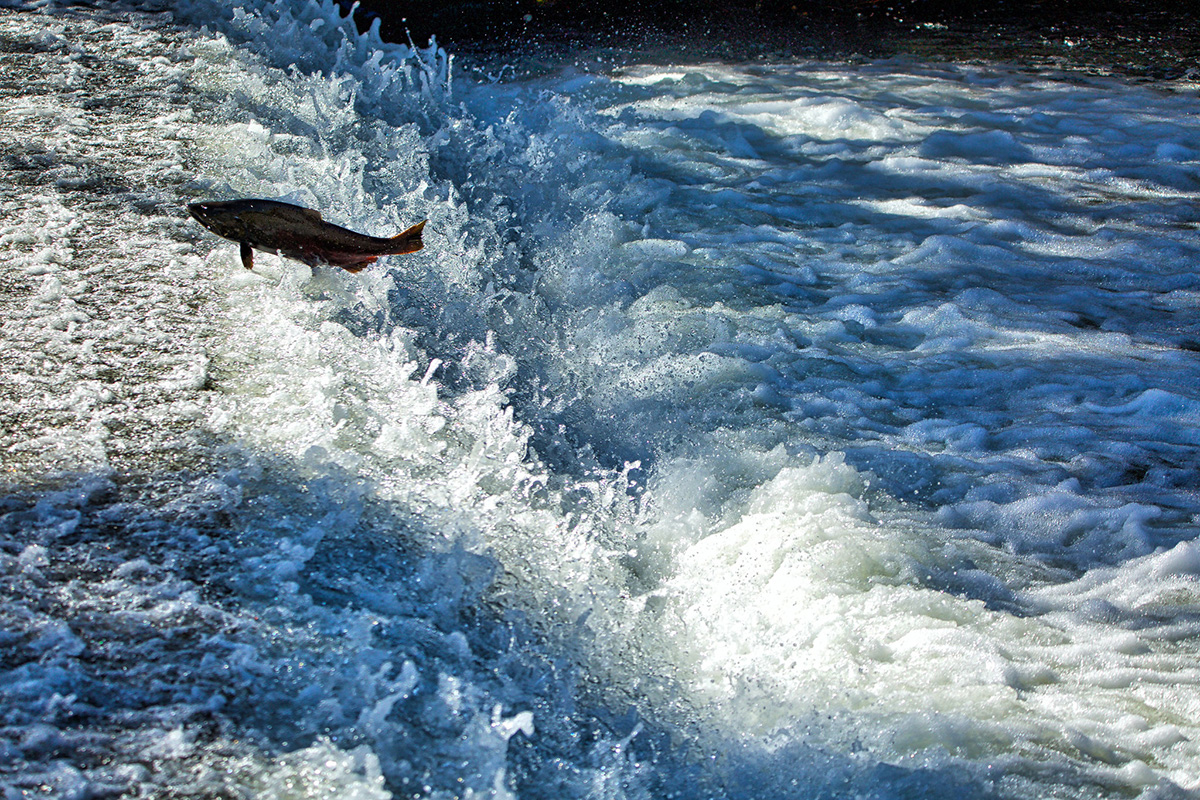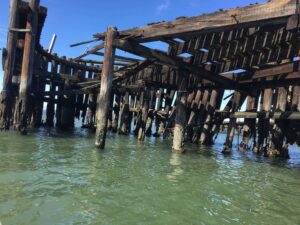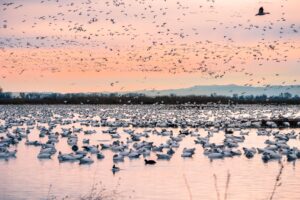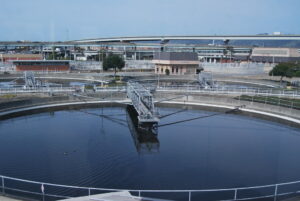The conflict over California water, often compared to a war, rather resembles a geological process. As along an earthquake fault, surface spasms come and go. The latest twitch is an injunction momentarily halting some Trump Administration water plans. But the underlying pressures are a constant. They never stop exerting themselves.
For the San Francisco Bay, the Delta, and the Central Valley streams, the fundamental tension is the same as ever. The estuary and its feeder rivers are simply not getting the water they need to maintain plankton, salmon runs, the Delta smelt, orcas off the Golden Gate, revivifying currents in the South Bay—indeed almost any aspect of the system that once existed. Something over half the available runoff on average is diverted to farms and cities, an amount that has been creeping upwards for decades. That is too much—if we care for the environment at all.
For decades, too, the state and federal governments have been promising to improve matters. New beginnings are frequently proclaimed. Massive reports are written, often laboriously confirming old conclusions. Tests are done to see to what extent fixing up riverine habitats alone can substitute for lacking flow. (Verdict: not that much.) For all that the central obstacle is not technical but political. For the Bay system to get more water, somebody somewhere—probably many someones in many places—has to take less.
There is a body that has the power to force such a reallocation: the State Water Resources Control Board. It flexed that muscle a quarter century ago in the case of Mono Lake, requiring Los Angeles to reduce diversions from feeder streams so that fish and birds could survive. But the issues relating to the vast Bay watershed are incomparably harder.
In 2009, the Legislature gave the water board a new schedule to revise its then decade-old and clearly inadequate standards for the estuary and the streams, embodied in what is titled the Bay Delta Water Quality Control Plan.
As a first step, in 2010, the board published an estimate of what flows should be if environmental health had an absolute first claim. In that imagined world, 75 percent of natural runoff would be allowed to swirl down the streams, through the Delta, and ultimately out to sea. Put another way, human consumption, agricultural and urban, would have to shrink by over half.
No one expected that to happen. The next step—balancing environmental needs with human claims under what is called the public trust doctrine—was supposed to take place in 2014.
At every step of the process, irrigation districts and water agencies, including San Francisco’s, resisted change. Hearing followed hearing, study fleshed out study, delay extended delay. Deep compromises were agreed to. Much too deep, some environmental observers thought. Finally, in November 2018, the board was ready to act. It would start small, setting somewhat higher flows for the San Joaquin River and several of its tributaries. Bigger bites—the Sacramento River watershed next, and finally the Delta itself, including the all-important flows to San Francisco Bay—would follow.
On Election Night, Governor Brown and Governor-Elect Newsom jointly wrote the board asking for another month’s delay. The leaders wanted four weeks to advance a long-running parallel process: voluntary negotiations with water districts, aimed at attaining better flows and more fish with less surrounding fury. A breakthrough, state officials promised, was at hand.
December brought no substantive proposal, and the water board enacted its San Joaquin rules. It was a political reach too far. Within days of his inauguration, Newsom suspended the march toward regulation, declining to reappoint the veteran chair of the board Felicia Marcus. Voluntary agreements—always hoped for as an adjunct to formal rules—would now be the sole way forward. Water watchers crossed their fingers and wished the governor luck.
Fast forward a year.
On February 4, 2020, hoping to move a stammering process along, the California Natural Resources Agency released its own model proposal, titled a Framework of Voluntary Agreements. It purported to boost river flows by some 800,000 acre feet in many years (with much less change in very wet and very dry ones). The water would be freed up largely by paying farmers to fallow some agricultural land. A lot of new money would also go to habitat projects. Details were dangerously fuzzy, but the framework promised at least some improvement over the status quo.
After initial fanfare, silence has fallen over the Framework. At this writing, it appears that the negotiations are dead, undone in large part by decisions coming out of Washington, D.C.

Besides the water board, another force has control of major water faucets: the Endangered Species Act. Our two biggest water distributors, the federal Central Valley Project and the State Water Project, are governed by documents mislabeled Biological Opinions; these are actually sets of rules, dictating in some detail how the projects must be run to protect the Delta smelt, two runs of chinook salmon, green sturgeon, and orcas (which feed on the salmon). Until recently, Opinions dating to 2008 and 2009 were the law of the land (or law of the dam and canal); compared to the outdated state rules, they required more water for fish and sometimes limited pumping southward from the Delta.
They did not affect the many water districts unconnected to the big projects. They also were failing to bring back the fish as hoped. In the waning months of the Obama Administration, water officials asked for a review and revision, expected to produce refinement and a still stricter regime.
Enter President Trump, who had promised to get more water to San Joaquin Valley farmers at all costs. His Interior Department took charge of the “reinitiation of consultation” and turned it around 180 degrees. The proclaimed intent was now “to maximize water deliveries and optimize marketable power generation.” Early work that warned of harm to the species disappeared from view. On February 19, 2020, the president celebrated the final product in Bakersfield, saying, “We got it done, and we got it done fast.”
The two revised Opinions now state, among other things, that it’s fine to pump more water southward out of the Delta; it’s fine to release less water downstream toward San Francisco Bay; and its fine to release less water from Shasta Dam to meet the cold-water needs of salmon. These changes will free up about 500,000 acre-feet of water for the projects’ customers, at least a 10 percent boost. What they will not do, the documents blandly assert, is put any endangered species in further jeopardy.
For fear of upsetting the voluntary negotiations, Governor Newsom had so far declined to cross swords with the Trump Administration over water. Now there was little choice. On February 20, Attorney General Becerra brought suit in Northern California district court to set aside the new Biological Opinions. On May 12, the court issued a preliminary injunction blocking their implementation for the rest of the month. The real action is yet to come.
The state responded in a second way, promising that the State Water Project would take up some of the environmental burden the feds were laying down.
That was no easy matter, because the State Water Project is intertwined with the federal one. Each draws primarily from Sacramento River tributaries; each exports water southward through huge pumps at the southern fringe of the Delta. H20 molecules have no ownership tags. Since 1996, the projects have been operated as one, following the same environmental rules. Now the state promised to chart its own, more protective path.
The plan that emerged, though, did not push back very hard. It followed the federal model in loosening a number of fixed rules on the premise that subtle “real-time” management of flows would be just as good for fish. Sister agencies, among them the water board, protested. “It is not clear,” the board stated in a January letter, “that the proposed project would strengthen safeguards for fish or limit exports to existing levels.” Environmentalists were less polite. “It abandons the state’s responsibility to protect endangered species,” said Jon Rosenfield of San Francisco Baykeeper. But in the end the California Department Fish and Wildlife, following required ritual under California’s own Endangered Species Act, issued what is called an Incidental Take Permit. The deal was done.
Several environmental groups sued. But the scorn of one camp didn’t equate to approval by the other. For the water project’s biggest customers, the plan’s limited gestures toward maintaining fish flows were apparently too much. In an op-ed in CalMatters, Jennifer Pierre, General Manager to the State Water Contractors, accused Newsom of “an unfortunate choice . . . that pushes stakeholders away from collaboration and back toward conflict and litigation.” The Voluntary Agreement process, she signaled, was over. On April 30, the contractors, too, went to court over the Incidental Take Permit.
“The old binaries” have reasserted themselves with a vengeance.
So where are we now? The Voluntary Agreements are a fading dream. Lowered standards for the big water projects, both state and federal, are on the books. Everybody’s back in court. Those who want more water for fish and estuarine systems have lost several key battles in a row.
Yet some advocates see grounds for hope in a situation grown so stark. A return, at least, of clarity. “The conflicts are standing out naked,” says Gary Bobker, director of The Bay Institute. “That’s not a bad thing.”
Other paths having played out, they dare to hope, the long march toward regulation of river flows just might resume.
It’s striking how often regulations or legal decisions have preceded, and opened the door to, successful negotiations. It happened after 1996 at Mono Lake. It happened after 2003 on the lower San Joaquin River, where a dried-up section of stream was restored. The water board’s 2018 decision on a first group of rivers, still on the books but unenforced, carefully left the door open to negotiated refinements.
Maybe the only way forward now is to turn the clock back to 2018 and pick up where we left off. Baykeeper’s Jon Rosenfield sees it this way: “The Newsom Administration now has the opportunity to pivot back to what the law requires.”





